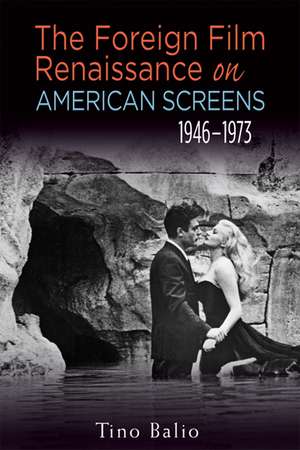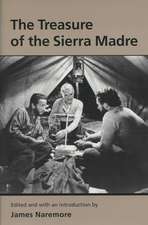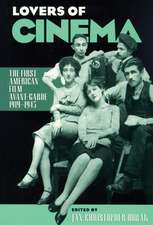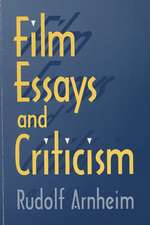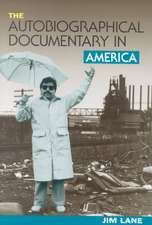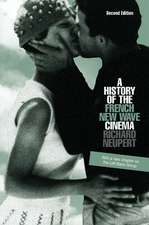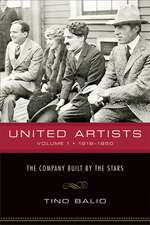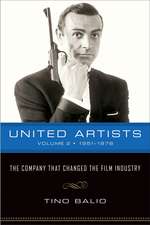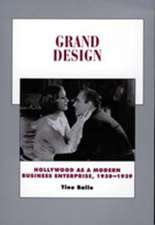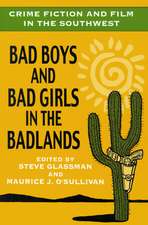The Foreign Film Renaissance on American Screens, 1946–1973: Wisconsin Film Studies
Autor Tino Balioen Limba Engleză Paperback – 4 noi 2010
Largely shut out of American theaters since the 1920s, foreign films such as Open City, Bicycle Thief, Rashomon, The Seventh Seal, Breathless, La Dolce Vita and L’Avventura played after World War II in a growing number of art houses around the country and created a small but influential art film market devoted to the acquisition, distribution, and exhibition of foreign-language and English-language films produced abroad. Nurtured by successive waves of imports from Italy, Great Britain, France, Sweden, Japan, and the Soviet Bloc, the renaissance was kick-started by independent distributors working out of New York; by the 1960s, however, the market had been subsumed by Hollywood.
From Roberto Rossellini’s Open City in 1946 to Bernardo Bertolucci’s Last Tango in Paris in 1973, Tino Balio tracks the critical reception in the press of such filmmakers as François Truffaut, Jean-Luc Godard, Federico Fellini, Michelangelo Antonioni, Tony Richardson, Ingmar Bergman, Akira Kurosawa, Luis Buñuel, Satyajit Ray, and Milos Forman. Their releases paled in comparison to Hollywood fare at the box office, but their impact on American film culture was enormous. The reception accorded to art house cinema attacked motion picture censorship, promoted the director as auteur, and celebrated film as an international art. Championing the cause was the new “cinephile” generation, which was mostly made up of college students under thirty.
The fashion for foreign films depended in part on their frankness about sex. When Hollywood abolished the Production Code in the late 1960s, American-made films began to treat adult themes with maturity and candor. In this new environment, foreign films lost their cachet and the art film market went into decline.
From Roberto Rossellini’s Open City in 1946 to Bernardo Bertolucci’s Last Tango in Paris in 1973, Tino Balio tracks the critical reception in the press of such filmmakers as François Truffaut, Jean-Luc Godard, Federico Fellini, Michelangelo Antonioni, Tony Richardson, Ingmar Bergman, Akira Kurosawa, Luis Buñuel, Satyajit Ray, and Milos Forman. Their releases paled in comparison to Hollywood fare at the box office, but their impact on American film culture was enormous. The reception accorded to art house cinema attacked motion picture censorship, promoted the director as auteur, and celebrated film as an international art. Championing the cause was the new “cinephile” generation, which was mostly made up of college students under thirty.
The fashion for foreign films depended in part on their frankness about sex. When Hollywood abolished the Production Code in the late 1960s, American-made films began to treat adult themes with maturity and candor. In this new environment, foreign films lost their cachet and the art film market went into decline.
Din seria Wisconsin Film Studies
-
 Preț: 189.69 lei
Preț: 189.69 lei -
 Preț: 209.74 lei
Preț: 209.74 lei -
 Preț: 150.39 lei
Preț: 150.39 lei -
 Preț: 332.28 lei
Preț: 332.28 lei -
 Preț: 222.96 lei
Preț: 222.96 lei -
 Preț: 151.58 lei
Preț: 151.58 lei -
 Preț: 218.25 lei
Preț: 218.25 lei -
 Preț: 231.35 lei
Preț: 231.35 lei -
 Preț: 218.12 lei
Preț: 218.12 lei - 23%
 Preț: 472.68 lei
Preț: 472.68 lei -
 Preț: 198.57 lei
Preț: 198.57 lei -
 Preț: 256.02 lei
Preț: 256.02 lei - 23%
 Preț: 478.76 lei
Preț: 478.76 lei - 23%
 Preț: 478.76 lei
Preț: 478.76 lei - 20%
 Preț: 414.21 lei
Preț: 414.21 lei - 12%
 Preț: 268.68 lei
Preț: 268.68 lei - 15%
 Preț: 585.00 lei
Preț: 585.00 lei - 19%
 Preț: 435.76 lei
Preț: 435.76 lei -
 Preț: 280.98 lei
Preț: 280.98 lei -
 Preț: 410.70 lei
Preț: 410.70 lei
Preț: 160.27 lei
Nou
Puncte Express: 240
Preț estimativ în valută:
30.67€ • 32.09$ • 25.48£
30.67€ • 32.09$ • 25.48£
Carte disponibilă
Livrare economică 12-26 martie
Preluare comenzi: 021 569.72.76
Specificații
ISBN-13: 9780299247942
ISBN-10: 0299247945
Pagini: 362
Ilustrații: 50 b-w film stills
Dimensiuni: 152 x 229 x 23 mm
Greutate: 0.53 kg
Ediția:1
Editura: University of Wisconsin Press
Colecția University of Wisconsin Press
Seria Wisconsin Film Studies
ISBN-10: 0299247945
Pagini: 362
Ilustrații: 50 b-w film stills
Dimensiuni: 152 x 229 x 23 mm
Greutate: 0.53 kg
Ediția:1
Editura: University of Wisconsin Press
Colecția University of Wisconsin Press
Seria Wisconsin Film Studies
Recenzii
“Balio revisits the most exciting period in the history of world cinema, reminding us how movies suddenly, briefly became a vital force in modern intellectual life.”—Richard B. Jewell, author of The Golden Age of Cinema: Hollywood, 1929–1945
“A major contribution to film historical scholarship. Balio charts the fascinating careers of foreign films in the American market, complete with comprehensive details of their marketing, box-office success or failure, and reception by critics.”—Sarah Street, author of Transatlantic Crossings: British Feature Films in the USA
“For movie buffs, this is an indispensable and deeply fascinating book.”—Booklist
“A remarkable resource of information, strengthening our understanding of art films as industrial products existing within an economic context and the significant impact they had on the mainstream U.S. industry.”—Film Quarterly
Notă biografică
Tino Balio is professor emeritus of film in the Department of Communication Arts at the University of Wisconsin–Madison and former director of the Wisconsin Center for Film and Theater Research. He is author of United Artists, Volume 1, 1919–1950 and Volume 2, 1951–1978 as well as Grand Design: Hollywood as Modern Business Enterprise, 1930–1939. He is editor of The American Film Industry and Hollywood in the Age of Television.
Cuprins
Introduction
Part One: Emergence
1 Antecedents
2 Italian Neorealism
3 British Film Renaissance
Part Two: Import Trends
4 Market Dynamics
5 French Films of the 1950s
6 Japanese Films of the 1950s
7 Ingmar Bergman: The Brand
8 French New WAve
9 Angry Young Men: British New Cinema
10 Second Italian Renaissance
11 Auteurs From Outside the Epicenter
Part Three: Changing Dynamics
12 Enter Hollywood
The Aura of the New York Film Festival
Collapse
Part One: Emergence
1 Antecedents
2 Italian Neorealism
3 British Film Renaissance
Part Two: Import Trends
4 Market Dynamics
5 French Films of the 1950s
6 Japanese Films of the 1950s
7 Ingmar Bergman: The Brand
8 French New WAve
9 Angry Young Men: British New Cinema
10 Second Italian Renaissance
11 Auteurs From Outside the Epicenter
Part Three: Changing Dynamics
12 Enter Hollywood
The Aura of the New York Film Festival
Collapse
Descriere
Largely shut out of American theaters since the 1920s, foreign films such as Open City, Bicycle Thief, Rashomon, The Seventh Seal, Breathless, La Dolce Vita and L’Avventura played after World War II in a growing number of art houses around the country and created a small but influential art film market devoted to the acquisition, distribution, and exhibition of foreign-language and English-language films produced abroad. Nurtured by successive waves of imports from Italy, Great Britain, France, Sweden, Japan, and the Soviet Bloc, the renaissance was kick-started by independent distributors working out of New York; by the 1960s, however, the market had been subsumed by Hollywood.
From Roberto Rossellini’s Open City in 1946 to Bernardo Bertolucci’s Last Tango in Paris in 1973, Tino Balio tracks the critical reception in the press of such filmmakers as François Truffaut, Jean-Luc Godard, Federico Fellini, Michelangelo Antonioni, Tony Richardson, Ingmar Bergman, Akira Kurosawa, Luis Buñuel, Satyajit Ray, and Milos Forman. Their releases paled in comparison to Hollywood fare at the box office, but their impact on American film culture was enormous. The reception accorded to art house cinema attacked motion picture censorship, promoted the director as auteur, and celebrated film as an international art. Championing the cause was the new “cinephile” generation, which was mostly made up of college students under thirty.
The fashion for foreign films depended in part on their frankness about sex. When Hollywood abolished the Production Code in the late 1960s, American-made films began to treat adult themes with maturity and candor. In this new environment, foreign films lost their cachet and the art film market went into decline.
From Roberto Rossellini’s Open City in 1946 to Bernardo Bertolucci’s Last Tango in Paris in 1973, Tino Balio tracks the critical reception in the press of such filmmakers as François Truffaut, Jean-Luc Godard, Federico Fellini, Michelangelo Antonioni, Tony Richardson, Ingmar Bergman, Akira Kurosawa, Luis Buñuel, Satyajit Ray, and Milos Forman. Their releases paled in comparison to Hollywood fare at the box office, but their impact on American film culture was enormous. The reception accorded to art house cinema attacked motion picture censorship, promoted the director as auteur, and celebrated film as an international art. Championing the cause was the new “cinephile” generation, which was mostly made up of college students under thirty.
The fashion for foreign films depended in part on their frankness about sex. When Hollywood abolished the Production Code in the late 1960s, American-made films began to treat adult themes with maturity and candor. In this new environment, foreign films lost their cachet and the art film market went into decline.
